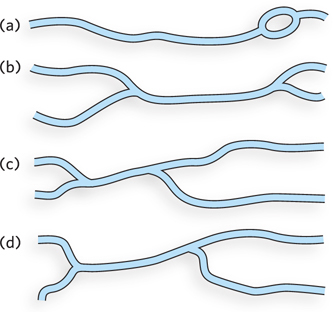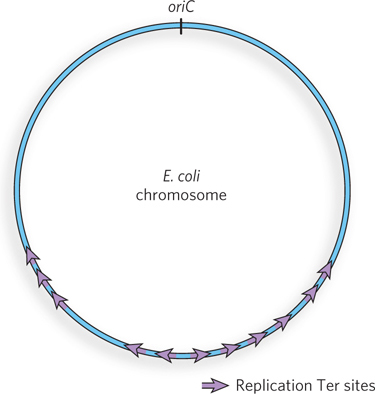PROBLEMS
Question 11.1
Shown below are cartoon drawings of four molecules observed in the electron microscope after cutting a circular plasmid once with a restriction enzyme. Does this plasmid replicate bidirectionally or unidirectionally from the origin? Explain. Order the molecules by time of replication, from the earliest to the latest.

Question 11.2
A DNA polymerase cannot synthesize a DNA strand de novo from a mixture of deoxynucleotide triphosphates. Explain the role of the primer and template in the reaction promoted by this enzyme.
Question 11.3
Arthur Kornberg and his colleagues incubated an extract of E. coli with a mixture of dATP, dTTP, dGTP, and dCTP. Only the dTTP was labeled with 32P in the α-phosphate group. After incubation, the mixture was treated with trichloroacetic acid to precipitate DNA, but not the dNTPs. The precipitate was collected, and the extent of [32P]dTMP incorporated into DNA was determined.
If any one of the dNTPs were omitted from the incubation mixture, would radioactivity be found in the precipitate? Explain.
Would radioactivity be found in the precipitate if 32P labeled the β- or γ-phosphate position? Explain.
Question 11.4
Provide at least two observations suggesting that Pol I is not the chromosomal replicase.
Question 11.5
You are characterizing a new DNA polymerase. When the enzyme is incubated with [32P]DNA and no dNTPs, you observe the release of [32P]dNMPs. This release is prevented by adding unlabeled dNTPs. Explain the reactions that most likely underlie these observations. What would you expect to observe if you added pyrophosphate instead of dNTPs?
Question 11.6
Explain how the enzymes that join together Okazaki fragments ensure that all the RNA is removed from the ends of fragments before they are sealed.
Question 11.7
A key step in the initiation of replication in bacteria is to load the DnaB helicase onto the DNA at the replication origin. What proteins function at the replication origin during initiation prior to the loading of DnaB?
Question 11.8
A DNA fragment containing an origin has been identified, using the recombinant plasmid approach (see this chapter’s How We Know section). The origin contains six short palindromes: four A sites of similar sequence, and two B sites unrelated to the A sites.
Assuming that three of the A sites are essential, explain an approach to identify which ones are necessary for origin function.
Plasmids with a mutation in either of the B sites still replicate. What additional experiment would you do to determine whether B-
site function is necessary at all?
Question 11.9
Five DNA polymerases have been identified in E. coli. Two of them—
410
Question 11.10
In eukaryotes, DNA replication occurs in the S phase of the cell cycle. However, important preparatory events occur in the G1 phase, prior to S phase. Describe these events and the status of eukaryotic replication origins as a cell enters S phase.
Question 11.11
Eukaryotic origins are tightly regulated so as not to fire more than once during S phase. Explain the key points of regulation of this process in eukaryotic cells.
Question 11.12
Explain the role of the τ subunit of Pol III.
What is the minimum number of τ subunits that must be present in Pol III to coordinate leading-
and lagging- strand DNA synthesis at a replication fork? Explain your answer. How many τ subunits must be present to allow Pol III to extend an oligonucleotide primer processively on a single-
stranded template in vitro? Explain your answer. How many τ subunits are actually present in an active Pol III replisome acting at a replication fork in vivo? Explain the function of these τ subunits.
Question 11.13
The AAA+ ATPases are the wrenches and crowbars of DNA metabolism. Briefly indicate what is accomplished when ATP is hydrolyzed by each of the following AAA+ ATPases: DnaA, DnaC, and the γ or τ subunits of Pol III.
Question 11.14
The replication termini (Ter sites) on the E. coli chromosome are oriented as shown below. Briefly describe what would happen in one round of replication if the orientations of all the Ter sites in the chromosome were reversed.

Question 11.15
The enzyme telomerase is considered a reverse transcriptase, synthesizing DNA on an RNA template. What is the source of the RNA used in the synthesis of telomeres, where is it located, and how many nucleotides of the RNA are actually used as template for DNA synthesis?